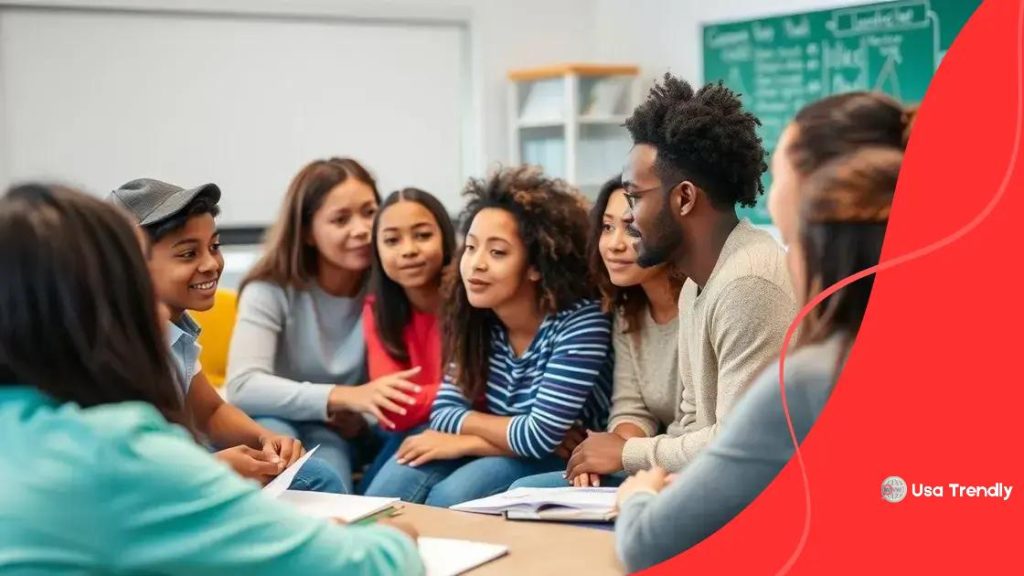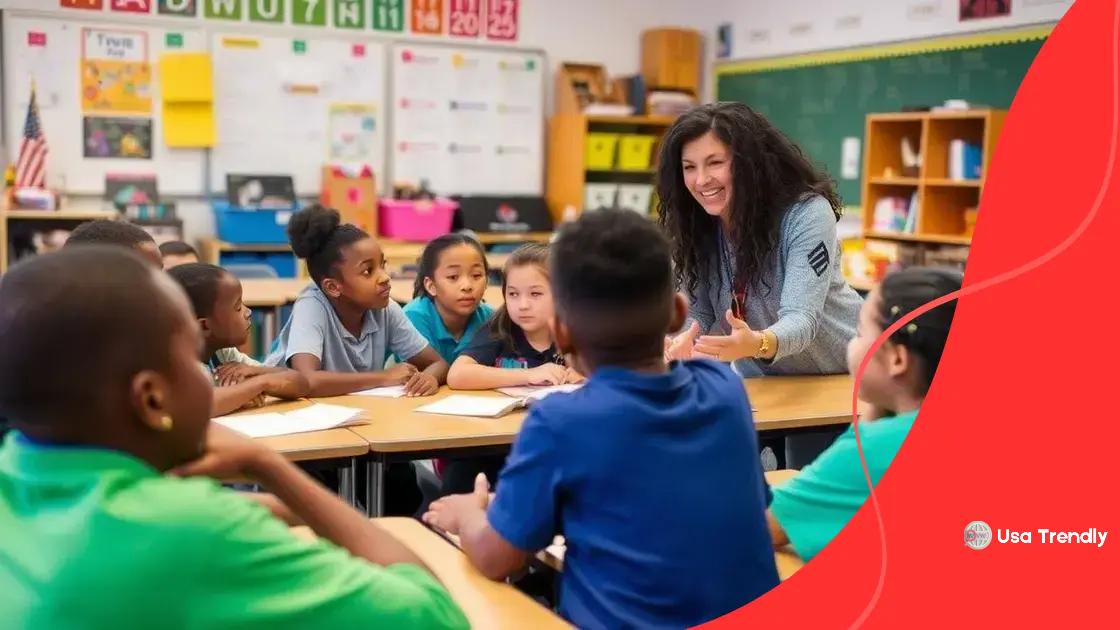Education policy reforms proposed by administration

Education policy reforms proposed by administration aim to enhance student achievement, support teachers, and foster community engagement through technology integration and a focus on lifelong learning.
Education policy reforms proposed by administration are creating a buzz in our schools and communities. What changes are on the horizon and how will they affect students and educators alike? Let’s dive into the details!
Understanding the proposed education reforms
Understanding the proposed education reforms is essential for grasping how changes in policy will impact students, teachers, and communities. These reforms are designed to address key challenges faced in the education system, ensuring that every student has access to quality education.
Key Aspects of the Reforms
One of the main goals of these reforms is to enhance student achievement. This means not only improving test scores but also fostering a love for learning. Educators are now focusing on student-centered learning, which emphasizes personalized education.
- Improving teacher training and support
- Increased funding for underprivileged schools
- Focus on STEM education
- Access to technology and resources
Moreover, the reforms aim to involve parents and communities more actively. This is crucial because when families engage with schools, students tend to perform better. Strategies include regular communication between teachers and parents and inviting community members to participate in school events.
Impact on Curriculum
The curriculum is also undergoing changes to match the needs of today’s world. There is a noticeable shift towards critical thinking and problem-solving skills, preparing students not just for tests but for real-life challenges. In addition, there is a growing emphasis on social-emotional learning, which helps students manage their emotions and build relationships.
With these changes, education systems are not just about delivering knowledge but about nurturing well-rounded individuals ready to face the future. These reforms highlight the connection between education and society, showing that improving schools is a collective responsibility.
In summary, understanding the proposed education reforms reveals a proactive approach to create a better educational environment. By focusing on critical factors, these reforms promise to enhance overall student success and community involvement.
Key goals of the administration’s policy changes
Understanding the key goals of the administration’s policy changes provides insight into the direction of education reforms. These goals aim to create a more equitable and effective education system for all students.
Enhancing Student Achievement
A primary goal is to enhance student achievement across the board. This includes raising standards and ensuring that every student can meet them. Schools will focus on core subjects, but also on developing critical thinking skills that prepare students for future challenges.
- Implementing rigorous academic standards
- Providing resources for underserved schools
- Encouraging innovative teaching methods
- Supporting holistic student development
In addition, there is an emphasis on closing achievement gaps among different groups of students. The administration recognizes that students come from various backgrounds, and these differences can impact learning. Addressing these gaps is essential for equity.
Supporting Teachers and Educators
Another key goal focuses on supporting teachers. By providing better training and resources, the administration aims to create a more supportive environment for educators. Effective teachers are crucial for student success, and investing in their development leads to positive outcomes.
Professional development programs will be enhanced to offer educators the tools they need. Additionally, teacher retention strategies will be implemented to maintain a stable workforce, benefiting both teaching quality and student learning.
Ensuring that every student feels supported requires a focus on social-emotional learning. Policies will include initiatives that promote mental health resources and create a supportive school climate where students can thrive.
Overall, understanding these key goals of the administration’s policy changes reveals a comprehensive approach to improving the education system. With a focus on student achievement and teacher support, these reforms aim to create a brighter future for education.
Impact on students and teachers

The impact on students and teachers from the proposed education reforms is significant and far-reaching. These changes aim to create a more effective learning environment that benefits everyone involved.
Improved Learning Outcomes
One of the most important impacts is the potential for improved learning outcomes. With tailored educational approaches, students will have better access to resources that suit their individual learning styles. By enhancing instructional methods, teachers can address diverse needs in their classrooms.
- Personalized learning plans based on student strengths
- Increased engagement through interactive teaching methods
- Access to modern technology and tools
- Opportunities for hands-on learning experiences
Moreover, these reforms promote the use of technology in the classroom. When students engage with digital learning tools, they often find lessons more engaging. This leads to higher motivation and enthusiasm for learning.
Support for Teachers
Teachers also stand to benefit significantly from these reforms. By receiving ongoing professional development and resources, they can refine their teaching strategies and grow in their careers. A well-supported teacher is more effective and can inspire their students.
With access to workshops and collaboration time with peers, teachers can share best practices. This collaboration helps build a community among educators, fostering innovative teaching approaches. Importantly, a positive school culture, where teachers feel valued, enhances job satisfaction and reduces turnover.
As reforms roll out, monitoring their impact on both students and teachers will be essential. Gathering feedback from those most affected will help refine strategies and ensure that the changes lead to desired results. Ultimately, understanding the impact on students and teachers is crucial for the success of these educational reforms.
Community response to education reforms
The community response to education reforms plays a crucial role in shaping the effectiveness of these changes. As new policies are proposed, educators, parents, and local organizations all weigh in on how they affect students and the wider community.
Engagement and Feedback
Community engagement is key to successful education reforms. Schools often hold meetings to discuss upcoming changes, inviting feedback from parents and local residents. This ensures that the voices of those directly involved in the education system are heard. Parents want to know how reforms will impact their children and what support will be available.
- Community forums for open discussion
- Surveys to gather opinions from parents and students
- Collaboration with local organizations for resources
- Active social media discussions to raise awareness
Also, community members may express concerns about how reforms will impact school funding and resources. They often worry about maintaining quality education for all students. Addressing these concerns proactively fosters trust and cooperation between schools and the community.
Support and Advocacy
Many communities organize advocacy groups to support education reforms. These groups may include parents, educators, and local leaders working together to promote positive changes. They often lobby for additional funding or resources to ensure that the reforms are effectively implemented. Grassroots movements can bring about significant changes in local policies by creating awareness and pressure.
Seeing community members actively participate in discussions or initiatives can empower others to get involved. This sense of unity enhances support for reforms and emphasizes the importance of education in shaping a successful community. Local businesses may also contribute by providing sponsorship or resources, further bridging the gap between education and the local economy.
Overall, understanding the community response to education reforms highlights the importance of collaboration. When everyone works together, reforms are more likely to succeed and benefit students, teachers, and families alike.
Future implications for the education system
The future implications for the education system stemming from these reforms are vast and important. As we move forward, adapting to new teaching methods and technologies will be crucial to meet the needs of all learners.
Increased Focus on Technology
One of the most significant implications is the increased integration of technology in classrooms. Schools will likely adopt more digital tools and online resources. This shift encourages interactive and personalized learning experiences for students, making education more engaging.
- Adoption of digital textbooks and resources
- Utilization of online assessments for better tracking
- Encouraging coding and digital literacy skills
- Remote learning options for flexible education
Moreover, training opportunities for teachers to implement technology effectively will become essential. Teachers will need to feel comfortable using these tools to enhance classroom learning.
Emphasis on Lifelong Learning
Another implication is a heightened emphasis on lifelong learning. The education system will work to ensure that students are not just equipped with facts but with skills needed for the future job market. Skills such as critical thinking, collaboration, and adaptability will be integral.
As workplaces evolve rapidly due to technological advancements, education will need to prepare students for a dynamic world. Curricula will increasingly focus on preparing students to continue learning throughout their lives, adapting to new challenges as they arise.
Stronger Community Partnerships
Future education reforms are also likely to strengthen community partnerships. Schools will collaborate more with local businesses, organizations, and families to support educational initiatives. These partnerships can provide resources, mentorship, and real-world learning opportunities for students.
By connecting with the community, schools can create relevant learning experiences that meet the needs of both students and local employers. This collaboration enhances the educational experience, ensuring that students understand the value of their education in the broader community context.
In summary, the future implications for the education system hold great promise. With a focus on technology, lifelong learning, and community engagement, these reforms can shape a more effective and responsive education system.
FAQ – Frequently Asked Questions about Education Policy Reforms
What are the main goals of the education reforms?
The main goals include improving student achievement, supporting teachers, integrating technology, and fostering community engagement.
How will technology be integrated into the classroom?
Technology will be incorporated through digital tools, online resources, and interactive learning methods to enhance student engagement.
What role do community partnerships play in these reforms?
Community partnerships help schools gain resources, support, and real-world learning opportunities, creating a stronger educational environment.
How can parents and community members get involved?
Parents and community members can participate in forums, provide feedback, and engage in advocacy efforts to support the success of education reforms.
SEE MORE CONTENT